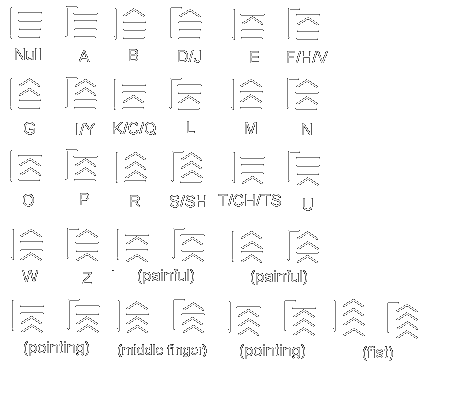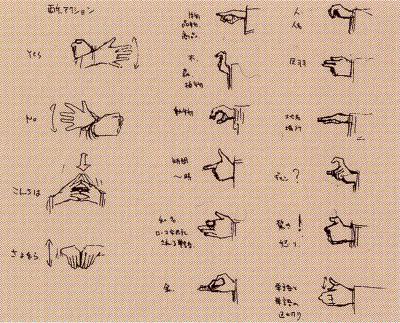 |
||
|
Renmei Sign Langauge: Tooga Language Decoder - Includes all of the possible japanese phonetics. A short explanation of the alternate/missing letters: F, H and V share the same hane. I and Y share the same hane. C and Q share the same hane as K. Same principle as the I/Y reason, because they're phonetically identical in sound, plus they are not really traditionally found in the Japanese phonetic system. S and SH share the same hane. T, CH and TS share the same hane. X is ommitted. - Other than these, the rules follow as it would have in a roman alphabetical system - Some hane are blank possibly because they're too painful to do quickly, or they may be misrepresented for some other gesture
- So far, only the right-hand hane have been decoded. Left-hand hane and advanced hane were not discernable from any information we have at hand. There are 2 that I can only guess at but are not 100% guaranteed to be accurate. - Also, alternate right-hand hane notation can be in the form
of binary numbers. Officially, in the haibane hakusho, they used
this format (even though I think it's a wierd way of putting it). Legend: Tooga alphabet guide: Right-hand hane
|Left-hand hane (symbol meaning haibane. this is why it is found right under Kuu's name) ^| (symbol meaning human, gesture is made by curling the hand in an inverse v/u shape) -| (?)/(?) (?)/(angry) Non-alphabet gestures: - These are all from the list in the haibane hakusho included in cog.4. It's not complete because I'm struggling to read the tiny notes on the equally tiny picture they included of the chart they worked from. So a lot are going to be left as (?) until I can decipher them.
Yes - Right hand with fingers splayed, left hand in a fist. Gesture is made by shaking the right hand up and down. No - Left hand with fingers splayed, right hand in a fist. Gesture is made by shaking the left hand up and down. Hello/konnichiwa - Right and left hand fingers splayed, touching each other at the tips forming the shape of a triagular cylinder, gesture is made with the fingers pointing upward and rotating downward until pointing at the recipient of the greeting. Good bye/sayonara - Right and left hands forming the shape of a duck bill with both index fingers against each other. Gesture is made with an up and down motion of both hands. Tree/woods/(?) - Fingers forming a crane shape, thumb parallel to the palm, palm is level to the vertical when facing recipient. Private property - Fingers and thumb curled to from the shape of a c, palm is almost level to the horizontal when facing recipient. (?)/time - Index finger pointing slightly downwards from horizontal, thumb pointing straight up, rest of the fingers curled to form a fist, back of hand facing recipient. (?) - Index finger folded to form a reverse v jutting out of the plane formed by the rest of the fingers pointing straight out, thumb is in neutral, back of hand facing recipient. Money - Index and thumb curled to form the shape of an o, the rest of the fingers pointing outward. the palm is level to the horizontal and facing upwards when facing the recipient. (?) - Index finger and thumb curled to from the shape of a c, rest of the fingers curled to a fist, palm is level to the horizontal and facing downwards when facing the recipient. (?)/(?)/(?) - Hand curled to the shape of a v, back of palm facing recipient. Gesture is made by moving the thumb up and down. ------ End of Document compiled by charp based on orig. decoder by megane. This document may be freely distributed only in its unedited form and may not be sold or printed for profit without permission from the author(s). Ver. 1.2 <4/1/03> Hand signs from Haibane Hakusho. Tooga written language signs by Wraith. |
||
|
Copyright 2003 - wraith@ssw.net
Images Copyright Pioneer and/or yoshitoshi ABe unless otherwise noted |


